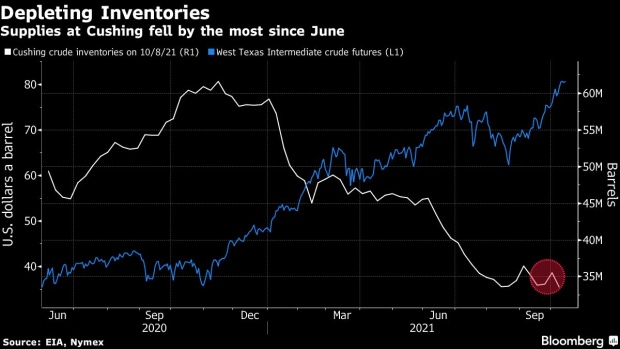Oct 14, 2021
U.S. Oil Hub Supplies Dwindle as Energy Squeeze Draws Exports
, Bloomberg News

(Bloomberg) -- Crude oil inventories at the biggest storage hub in the U.S. posted their steepest decline this week than in any October in five years as demand for exports and from refineries pull barrels to the Gulf Coast instead.
Inventories at Cushing, Oklahoma, dropped by about 2 million barrels to the lowest since 2018, according to the Energy Information Administration. The last time Cushing saw this much oil removed in October was in 2016.
Cushing is the delivery point for benchmark West Texas Intermediate futures and supply-demand balances at the hub drive millions of dollars worth of trading in the markets every day. A global energy supply crunch has boosted demand for U.S. crude overseas and at home, prompting traders to bring crude out of storage at a time when domestic refiners typically pare back output to conduct maintenance.
Demand for light sweet crude from Europe, which is cheaper to process than heavy crude, is attracting exports from the U.S. that might have gone to Cushing, said Robert Campbell, head of oil products research for consultancy Energy Aspects.
“The sweet crude market is where the strength is right now, and the U.S. is the last real supplier of sweet crude,” Campbell said.
Flows on pipelines from Midland, Texas, the heart of the Permian basin, to Cushing were muted last week, traders said.
Stockpiles typically rise during this time of the year as refineries conduct maintenance activities after peak summer driving season. But this year, a recovery in global demand has sent retail fuel prices to seven-year highs, incentivizing fuelmakers to produce as much gasoline and diesel as possible.
Earlier this week, the spread between November and December WTI futures -- known as the prompt timespread -- surged to the widest premium in more than two years. That’s a bullish condition here more immediate supplies fetch big premiums over later date contracts, reducing the incentive to store oil.
©2021 Bloomberg L.P.


